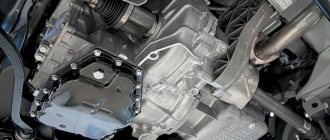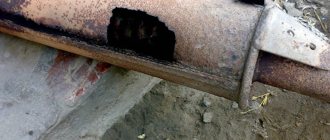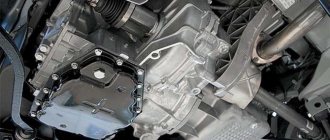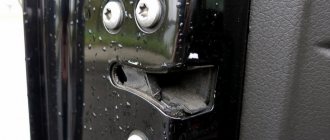How to skid on the spot? Using the example of mechanics and automatic transmission
Download PDF
Having a manual or automatic transmission installed, how to slip in place? Will this cause harm to units and components? We will answer these questions and more in this section. It is no secret that this nonsense affects mainly young and impulsive drivers (street racers) who do not know a lot about technology and the cost of breakdowns. As they say, the main thing is to put your slippers on the floor
. In this way, guys try to stand out from the crowd in front of friends and colleagues, as well as attract the attention of girls. But what will follow such antics? In what condition will the car return home then? It’s good if it’s yours, not your father’s. Do you understand what I'm talking about. But there is another side to the coin...
How to slip?
Some people consider spinning to be pranks that young people do for fun. But it is not always the case. In drag racing, skidding heats up the tires. The slipping technique will vary depending on the type of transmission.
How to slip on mechanics
In order to start slipping in a car with a manual transmission, press the brake and gas pedals at the same time. At the same time, do not press the brake pedal all the way. The engine picks up speed, and when to release the clutch is up to whoever is driving.
How to slip on automatic
Without harm to the car, you can slip with an automatic transmission using neutral. Naturally, each gearbox has its own characteristics, but before you start drifting in place, it’s a good idea to read the instruction manual.
Recommendations
There are some rules regarding proper slippage.
- You can’t skid in place for a long time, because the gearbox needs rest. Skid periodically, so both the driver and the car will rest. There is no need to turn off the engine while resting.
- You cannot skid on a cold car. Hasty actions will lead to wear of significant parts of the automatic transmission, since slipping will begin without any lubrication of the mechanism.
- Before attempting to drive out of a snowdrift, turn on R mode, first pressing the brake pedal. We stand in this position for at least a minute. During this time, the required amount of lubricant will be pumped through the torque converter.
- When skidding, you should avoid too sharp traction with the road. The higher the load, the faster the clutches on the automatic transmission will fail.
"Crank" on "automatic"
It's not that simple here
as it seems to some. It is possible to slip only if the road is slippery: ice, snow, or, in extreme cases, sand on the beach. You can't do this on asphalt. They say that some people manage to make a crank in the “neutral” mode on an automatic transmission, but one hardly believes in such fables.
Let's simulate the situation:
stuck in a snowdrift and need to get out with an automatic transmission. To do this, engage the “R” gear, before doing this we squeeze the foot brake.
In this mode, we wait about 3 minutes until the oil is pumped up by the torque converter and gradually begin to release the brake, increasing the speed. High speeds will quickly damage the automatic transmission clutches. Minimal cooling may cause the liquid to boil.
In a word, slipping is allowed, but within moderate limits.
Therefore, if you really want to learn the art of drag racing, first take training courses at any driving school and only after that feel free to get behind the wheel of your car. Actually, they gave a full answer to the question: how to skid on the spot. Always make an informed decision.
Source
Is it possible to slip on an automatic with all-wheel drive?
Guys often have automatic transmissions; on SUVs they are not much different - I mean the design. There is also a cooling radiator, as well as a torque converter and friction discs. Does this mean anything to you? True, in order to carry such a “carcass”, such transmissions can “digest” more torque than an ordinary foreign passenger car, it would be beyond sacrilege - for the boxes to be the same on a class “A” car and a heavy frame SUV. Still, the designs are slightly different; in SUVs it is stronger, if you want, reinforced or something.
But its weight is different, often approaching 3 tons, but an ordinary ordinary (classes “B” - “C”) foreign car weighs about 1 ton. Therefore, it will be more tense in the SUV.
BUT! It is worth noting that such cars have all kinds of differential locks, automatic gear reduction, all-wheel drive, high ground clearance, wide tires, and finally a transfer case. All this together helps to overcome snowy yards - WITHOUT EVEN THINKING! But again, returning to rally raids on special mud tracks, where sometimes special vehicles are pulled with winches, SUCH CARS are not designed! Yes, she will fight for a long time, and sometimes you can even pass the track. But what will be the consequences for your automatic transmission? Think about it, after this it is advisable to change the oil , filter, and diagnose your gearbox. Let me emphasize once again - for severe off-road use, MECHANICAL ONLY.
This is probably why UAZ vehicles now only have a manual transmission.
Now a useful video.
Actually, that's all, I think it was useful, read our AUTOBLOG.
Similar news
- What does ATF mean in an automatic transmission? What a transcript. Let's talk about oil
- Dirty and burnt oil in the automatic transmission and variator. What is dangerous and what is going on...
- Oil pressure in automatic transmission (automatic). What is it and how is it created?
Add a comment Cancel reply
SvarogovMSK › Blog › Answer: How to grind on site? How to burn rubber? How to do Burnout.
Good health. I don’t know why today I received such questions as “How to grind on site?”, “How to burn rubber?”, “How to do Burnout?”
etc. I don’t understand why they started asking me such questions, but I feel it won’t end with 4 guys and that’s why I decided to quickly answer everyone at once.
You can sand everything, even Zil 124 (Yes, it happened, I was about 13 years old and I was acting up, calm down.)
. Do you have a weak car? Do you feel sorry for the tires? It's simple. In winter on snow it is easy and without much harm to the tires, but there will be no smoke. In summer you can create a lot, a lot of smoke and the secret is simple. Take engine oil, pour it onto the asphalt, add water so that there is a puddle and just stand on the drive wheels and grind it, there will be a lot of smoke from the oil, but don’t forget that then you need to wash the tires if you drive on them, so that you will The road didn't get carried away and didn't get into an accident. Try to use bald tires on light rims for the drive wheels; you can even buy a used one and polish it.
Next and the most important thing is how to do it. The easiest way is on a front-wheel drive car with manual transmission.
Stand on snow, a puddle, or the consistency mentioned above, lift the clutch and as the gas begins to move off, the handbrake and it will begin to grind. Some people simply drive their drive wheels up to the curb and grind against it.
Automatic front wheel drive
The same thing, you just need to set the L3 mode and turn off the traction control.
With rear wheel drive on mechanics
it’s more difficult, here you need to have the wheels spinning and you press the brakes, and since the rear brakes will grab, it’s difficult to do this on a weak car, the same check, you need to make a system that will block the front wheels, but not the rear ones, also without the system will cause the brakes to overheat, and the old ones also have drum brakes, which is generally crap.
You can read about this in other articles (Not mine, I won’t describe this.)
.
For powerful cars this is overheating of the brakes, but it is still real. You need to depress the clutch with your left, press the brake with your right heel, and press the gas with your toe. By the way, in the new Dodge Challenger Hellcat
there is a button that blocks the front brakes and you only need to press the gas. The system is not difficult to create.
Automatic, rear wheel drive
, this is the most difficult thing, unless of course you have a system like the
Dodge Challenger Hellcat
. There is a very high probability that your box will simply collapse, so I won’t advise you and you need to run.
There is also special rubber that has the color of smoke, but it is expensive.
And most importantly, there are advisers who tell you to unscrew the brake hoses, but they apparently don’t know that most cars have a parallel system, and when you unscrew one hose, it is responsible for the front left and rear right brakes, and the other is for the front right and rear left brake. So let’s say it’s X-shaped, so that if 1 hose breaks, for example, then you will have 2 wheels brake on opposite sides, and not pull you to the side.
How to and how not to slip an automatic transmission
Novice car enthusiasts ask experts “whether it’s possible to skid with an automatic transmission.” Even before the automatic machine entered the lives of modern car owners, there were many debates on this topic. Some experts were even inclined to believe that with two radiators on a frame SUV, you can overcome mud and swamps.
But, after several dozen experiments, experienced car owners can accurately answer that skidding or a sharp start can only be done by mechanics. The automatic is designed for city roads and does not tolerate swamps.
How to slip in place on rear wheel drive
Many young people are interested in the question of how to skid on the spot?
Such actions are popular primarily among young, novice street racers who have bought their first car. At the same time, you should know that the consequences of this will not keep you waiting. This applies to both manual and automatic gearboxes. How to slip in place in a car with a manual transmission? If we consider the action from a professional point of view, then this is necessary in order to warm up the car’s tires before a quick start. A sport that requires quick heating of the tires is called “drag racing.” In this case, the specifics of the actions depend on the type of gearbox. In this case, you must perform the following steps:
On an automatic gearbox the situation is somewhat more complicated. This will require a slippery surface: snow, ice, sand. The procedure is to perform similar manipulations. The only difference is that it is not advisable to make long jerks. The engine of the car should cool down a little in seconds. It is not recommended to stop the engine at this moment; it should run at idle speed. In addition, the car must be warmed up to operating temperature. If this is not done, oil will not be supplied to the automatic transmission, and the result will be its subsequent replacement.
How to slip on mechanics
The methods of “freeing” from slipping for a car with a manual differ significantly from similar methods for an automatic transmission. The most common technique is rocking the car. The driver, quickly switching the first forward and reverse gears, rolls the car back and forth. After some time, as a result of this, as a rule, a small platform is created under the car, which is most often enough to, using an additional speed impulse, make a sharp start and escape from the trap.
Answers
Carrot asses 7 (34775) 2 11 26 2 g
I see that there will soon be another dead clutch. If you don’t know how and don’t have the finances for something cooler than a 20-year-old small-capacity bucket, don’t even try
7LivE 6 (8906) 2 7 28 2 g
gas + handbrake + stable degree of rotation and naturally the skill to be able to do this
Some people consider spinning to be pranks that young people do for fun. But it is not always the case. In drag racing, skidding heats up the tires. The slipping technique will vary depending on the type of transmission.
How to do slipping on the spot?
Some people consider spinning to be pranks that young people do for fun. But it is not always the case. In drag racing, skidding heats up the tires. The slipping technique will vary depending on the type of transmission.
How to slip on a manual transmission?
In order to start slipping in a car with a manual transmission, press the brake and gas pedals at the same time. At the same time, do not press the brake pedal all the way. The engine picks up speed, and when to release the clutch is up to whoever is driving.
How to slip on an automatic transmission?
Without harm to the car, you can slip with an automatic transmission using neutral. Naturally, each gearbox has its own characteristics, but before you start drifting in place, it’s a good idea to read the instruction manual.
Recommendations
There are some rules regarding proper slippage.
- You can’t skid in place for a long time, because the gearbox needs rest. Skid periodically, so both the driver and the car will rest. There is no need to turn off the engine while resting.
- You cannot skid on a cold car. Hasty actions will lead to wear of significant parts of the automatic transmission, since slipping will begin without any lubrication of the mechanism.
- Before attempting to drive out of a snowdrift, turn on R mode, first pressing the brake pedal. We stand in this position for at least a minute. During this time, the required amount of lubricant will be pumped through the torque converter.
- When skidding, you should avoid too sharp traction with the road. The higher the load, the faster the clutches on the automatic transmission will fail.
Which cars are not suitable for towing?
- Low efficiency of the cooling system can provoke a critical condition due to increased heat generation in the torque converter. The radiator will become clogged with wear products. Such difficulties are typical for cars with high mileage. Let's include here all American cars produced back in the 80s and 90s.
- Older Japanese and European cars have air transmission cooling systems. This means that the automatic transmission is cooled while driving, and therefore slipping on them can only be to the detriment of the “health” of the car. True, there are practically no such cars in Russia anymore, since they are small cars that rarely hit our market.
If you follow these simple rules, you can skid without causing any harm to your iron horse. You don’t want to pay for expensive repairs or buy new tires because of a simple mistake? Always be careful when driving.
How to make wheels slip while standing still (burnout)
Burnout - slipping, in professional slang means warming up the tires on a car standing still, that is, slipping of the tires themselves and rubbing them against the asphalt. As a result of the contact of the tires with the hard surface of the asphalt, they begin to quickly heat up and smoke appears from under them.
Burnout, the so-called slip, is used before races on the drag racing track for better tire grip and for better and more stable handling of a very powerful car on a rally track.
From the category of a necessary action, burnout skidding quickly moved into the category of a kind of entertainment, thus becoming an element of a certain show, where its participants demonstrate a higher level of car control using all its capabilities.
For burnout, i.e. for slipping, the following conditions are necessary:
1. The car is powerful enough to warm up the tires, otherwise the wheels will not be able to rotate at high speed.
2. The car must be technically sound. When this technique is put into practice, the loads on the engine, brake system, wheel bearings and suspension reach extreme values.
3. The car owner must be personally aware of the following fact: that such heating of the tires can, and sometimes does, lead to serious technical breakdowns.
Attention. The article was written with only one purpose, namely: to show the basics of the burnout technique. It in no way calls motorists to action. Any attempts to use this racing equipment for any entertainment or professional purposes may result in serious damage to the vehicle. Also, this type of activity can be dangerous both for the driver himself and for others. This slipping method should under no circumstances be used in crowded areas or on public roads. This is a mandatory requirement for all motorists.
Burnout technique, what you need to know about wheel slip on the spot: Video
WARNING! DO NOT USE THE BURNOUT TECHNIQUE IN PLACES OF LARGE CLOCKS OF PEOPLE AND ON PUBLIC ROADS!
Burnout, an effective technique for warming up tires or a spectacular way to show off in front of others. In any case, the ability to do a burnout will help you get a better feel for a car with a manual transmission and ruin a couple of tires.
An expert in auto mechanics and physics, Jason Fanske from the YouTube channel “Engineering Explained” again held a cultural education for his viewers. In a new form, Jason explained in detail the basics of the burnout technique, citing as an example his rear-wheel drive Honda S2000 with a manual transmission.
First, the video explains in what cases this technique is used and why it is needed.
-The coefficient of adhesion of cold tires to the road surface may be low and if necessary, it needs to be increased. If you warm up your tires, their temperature will increase, they will become softer and their grip will increase. Where is it used? Mainly in drag racing.
It is further mentioned (1.26 min video) that the process on an automatic transmission is quite simple. Press the brake, then press the gas. As soon as the wheels to which the drive is driven begin to rotate, weakening and increasing the pressure on the brake pedal, it is necessary to regulate the rotation of the wheels and prevent the car from moving.
Inscription at the top: Make sure the traction control is turned off!
On cars with a manual transmission, the narrator continues, everything is somewhat more complicated (1.47 min video). To do this you need:
- Depress the clutch
- Engage first gear
- Lightly press the accelerator pedal, release the clutch and immediately press the brake pedal with your left foot
As soon as you manage not to stall at this moment or to avoid slipping forward (in particular, due to the likelihood of uncontrolled acceleration of the car, burnout is so dangerous both for those around you and for the driver himself), proceed to working with the brake and gas pedals, also , as with an automatic transmission.
In addition to the equipment itself, the video mentions that it is extremely important to know at what speed the wheels of your car begin to slip on the asphalt. In the S2000, the author says, slippage begins at approximately 5,000 rpm. If you overclock the engine, there is a danger of burning the clutch instead of the tires; if the engine speed is not enough, the car will not have enough torque to overcome the grip of the tires on the road surface.
And finally, at 2.48 minutes of the video it shows how hot the tires are during a burnout. Note that the first few attempts were unsuccessful, but even so, the tire temperature increased by 4 degrees, from 15 to 19 degrees Celsius. Moreover, the inner side of the tire heated up the most, up to 20 degrees, due to the reverse camber of the wheels.
At the end of the action, the tires were heated to 160 degrees Celsius!
This is such an interesting educational program in the world of sports and automotive extremes.
Information publication: Traffic police news, accidents, traffic fines, traffic police, Online traffic rules exam. Technical inspection
Rear-wheel drive vehicles
II. Engage first gear, then fully depress the clutch and gradually begin to increase engine speed. With a quick but smooth movement, begin to release the clutch pedal, while still pressing the gas.
Attention. To prevent the speed from going into the red zone, work with the gas pedal very carefully; you do not need to press it all the way to the floor. The ideal execution technique is shown in the following video (1.00 minute video). Play with the gas pedal, alternately pressing it harder or weaker, while constantly keeping the speed high, but also safe for the engine.
Once the clutch is fully released, place your left foot on the brake pedal. In order to press the brake pedal with the required force with your left foot, some practice is required. It’s very difficult to do this the first time (and sometimes the tenth).
The braking force must be more than sufficient, and this is necessary so that the rear wheels of the car continue to rotate freely, while the car itself remains in place or continues to move very slowly forward.
Attention . Attempting to do a burnout for the first time, of course, will initially fail over and over again, and this will continue until you learn to feel the smallest nuances of the car's behavior. In this case, there is a possibility of overheating of the clutch itself, up to its failure. So try to monitor any unusual and foreign odors that appear in the car’s interior, as well as the behavior of the car itself when you turn on the gearbox and depress the clutch, precisely at the moment the clutch discs come together.
CARS WITH DSG AND CVT
As you understand, you can skid on an automatic transmission without harming the transmission. This may be due to the operating principle of the torque converter. By slipping, the main engine smoothes out shock loads. If the variator design requires the presence of a torque converter, then the car will endure trips on light off-road conditions much more calmly. But at the same time, you can only skid until the main engine is blocked. In general, you need to work with the gas pedal carefully to minimize increased loads on the belt and cones of the variator.
The disadvantage of the DSG device is precisely the absence of a torque converter. Therefore, clutch packs used in “wet” DSGs, as well as clutch discs of “dry” robotic gearboxes, experience increased loads on off-road roads.
Novice car enthusiasts ask experts “whether it’s possible to skid with an automatic transmission.” Even before the automatic machine entered the lives of modern car owners, there were many debates on this topic. Some experts were even inclined to believe that with two radiators on a frame SUV, you can overcome mud and swamps.
But, after several dozen experiments, experienced car owners can accurately answer that skidding or a sharp start can only be done by mechanics. The automatic is designed for city roads and does not tolerate swamps.
Front wheel drive cars
III. On front-wheel drive, burnout slipping is somewhat easier than on rear-wheel drive. To do this, you need to hold the parking brake, then raise the engine speed and just as smoothly and quickly release the clutch pedal. As a result of such a rapid (almost instantaneous) increase in speed of rotation of the front wheels, the car will not move forward and will not stall; remaining in one place, it will begin to release the desired and long-awaited puffs of smoke from under its tires.
On front-wheel drive, it is much easier to do burnout-slip. But there is one important nuance, namely: the car’s handbrake must be in good working order, it must be able to hold the car in one place.











